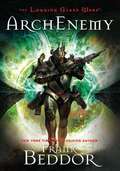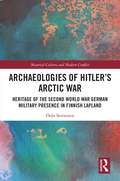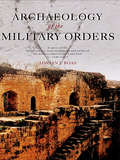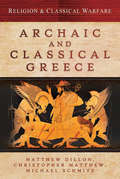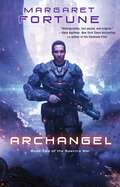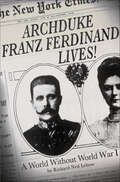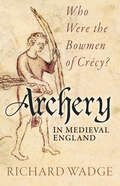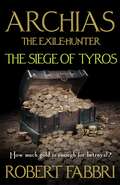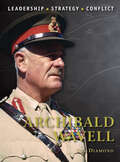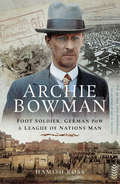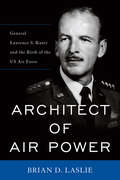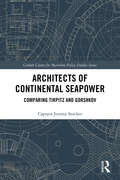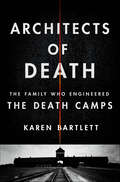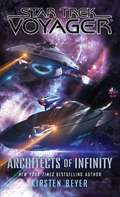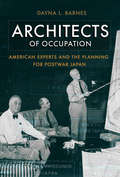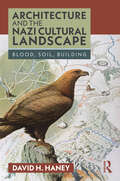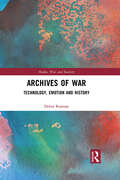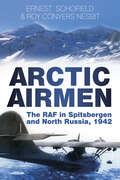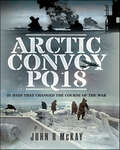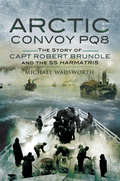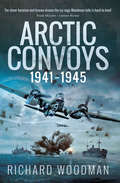- Table View
- List View
ArchEnemy (The Looking Glass Wars #3)
by Frank BeddorDiscover the fate of Wonderland -- and imagination itself -- in this riveting conclusion to "The Looking Glass Wars" trilogy. The Heart Crystal's power has been depleted, and Imagination along with it. The people of Wonderland have all lost their creative drive, and most alarmingly, even Queen Alyss is without her powers. There is some comfort in the fact that the vicious Redd Heart seems to be similarly disabled. Amazingly, she is attempting to team up with her enemy, Alyss, in order to reclaim Wonderland from King Arch. Alyss might have no choice but to accept Redd's overtures, especially when she begins to receive alarming advice from the caterpillar oracles.
Archaeological Approaches to and Heritage Perspectives on Modern Conflict: Beyond the Battlefields (Heritage and Memory Studies)
by Max SchriekFrom a wider disciplinary perspective, modern conflict archaeology is now a thoroughly established and mature subdiscipline. However, a significant problem conflict archaeologists in the Netherlands face is that modern eras, including both world wars, have so far not received serious attention. Although both world wars appeal strongly to the popular imagination, until recently, Dutch researchers had not approached modern conflict from an academic archaeological perspective to any great extent. This is partly the result of problematic legislation on archaeological activity in the Netherlands. When applied and interpreted appropriately, archaeology can play an important role in the preservation, contemporary experience and historical reconstruction of recent conflicts. However, as Archaeological Approaches to and Heritage Perspectives on Modern Conflict: Beyond the Battlefields argues, research methods other than excavations will be needed to conduct conflict archaeology in the Netherlands effectively. This study aims to develop a Dutch approach to conflict archaeology, integrating archaeology, heritage research and history at a landscape scale.
Archaeologies of Hitler’s Arctic War: Heritage of the Second World War German Military Presence in Finnish Lapland (Material Culture and Modern Conflict)
by Oula SeitsonenThis book discusses the archaeology and heritage of the German military presence in Finnish Lapland during the Second World War, framing this northern, overlooked WWII material legacy from the nearly forgotten Arctic front as ‘dark heritage’ – a concrete reminder of Finns siding with the Nazis – and as polluting ‘war junk’ that ruins the ‘pristine natural beauty’ of Lapland’s wilderness. The scholarship herein provides fresh perspectives to contemporary discussions on heritage perception and ownership, indigenous rights, community empowerment, relational ontologies, and the ongoing worldwide refugee crisis.
Archaeology of the Military Orders: A Survey of the Urban Centres, Rural Settlements and Castles of the Military Orders in the Latin East (c.1120-1291)
by Adrian BoasFirst Published in 2004. Routledge is an imprint of Taylor & Francis, an informa company.
Archaic and Classical Greece (Religion & Classical Warfare)
by Christopher Matthew Matthew Dillon Michael SchmitzEssays examining the influence of gods, oracles, and omens in the wars of the Archaic and Classical Greek world.Religion was integral to the conduct of war in the ancient world and the Greeks were certainly no exception. No campaign was undertaken, no battle risked, without first making sacrifice to propitiate the appropriate gods (such as Ares, god of War) or consulting oracles and omens to divine their plans. Yet the link between war and religion is an area that has been regularly overlooked by modern scholars examining the conflicts of these times. This volume addresses that omission by drawing together the work of experts from across the globe. The chapters have been carefully structured by the editors so that this wide array of scholarship combines to give a coherent, comprehensive study of the role of religion in the wars of the Archaic and Classical Greek world.Aspects considered in depth will include: Greek writers on religion and war; declarations of war; fate and predestination, the sphagia and pre-battle sacrifices; omens, oracles and portents, trophies and dedications to cult centers; militarized deities; sacred truces and festivals; oaths and vows; religion & Greek military medicine.Praise for Religion & Classical Warfare: Archaic and Classical Greece“Comprised of ten erudite and impressively informative articles by experts in the field of Greek antiquity. . . . A work of meticulous and detailed scholarship, Religion & Classical Warfare: Archaic and Classical Greece must be considered as a core addition to community, college, and university library Antiquarian Greek History collections and supplemental curriculum studies lists.” —Midwest Book Review
Archangel (Spectre War #2)
by Margaret FortuneArchangel is the second installment of the explosive, pulse-pounding Spectre War science fiction series.An enemy you can’t kill. A soldier who can’t fight. An interstellar war that can’t be won . . . until now. As a soldier of the Celestial Expanse, Guardian First Class Michael Sorenson knows better than anyone that when the Spectres invade, there are only two options. Run or die. However, his defensive war takes on a whole new spin when he’s recruited into Division 7, a Research & Development facility with the ultimate mission: to create a large-scale weapon that can kill Spectres en masse. Here Michael joins a team of military elite who have the daring—and dangerous—task of taking new weapons prototypes out into the field for testing on enemy troops. Yet the closer they come to developing a working WMD, the more it becomes clear: There’s a saboteur in R&D. With all signs pointing to a massive Spectre attack brewing on the horizon, the creation of a new weapons system yields an opportunity to end the threat once and for all. As the days count down toward its launch, Michael must hunt down the saboteur . . . before the saboteur hunts down him.
Archangel of Sedona
by Tony PelusoAt the site of a world-famous architectural marvel located in the heart of the mystical red rock country surrounding Sedona, Arizona, a young college student encounters an ancient secret that holds the key to the origins of the universe. Haunted by his epiphany over decades, unexplainable--almost miraculous--events overtake him, until he has a revelation that compels him to go on a dangerous quest to resolve the mystery.Archangel of Sedona documents the personal story of Tony, a veteran integrating his combat experiences with his metaphysical awakening in the Red Rock's atmosphere of infinite space and boundless silence. His hero's journey through both beauty and danger combines mystery, adventure, and spiritual discovery. There is no serendipity.
Archduke Franz Ferdinand Lives!: A World Without World War I
by Richard Ned LebowArchduke Franz Ferdinand Lives! presents an intellectually invigorating set of hypotheticals about the twentieth century--had we been smart enough to avoid World War I.The "Great War" claimed nearly 40 million lives and set the stage for World War II, the Holocaust, and the Cold War. More than one hundred years later, historians are beginning to recognize how unnecessary it was. In Archduke Franz Ferdinand Lives!, acclaimed political psychologist Richard Ned Lebow examines the chain of events that led to war and what could reasonably have been done differently to avoid it. In this highly original and intellectually challenging book, he constructs plausible worlds, some better, some worse, that might have developed. He illustrates them with "what-if" biographies of politicians, scientists, religious leaders, artists, painters, and writers, sports figures, and celebrities, including scenarios where: there is no Israel; neither John Kennedy nor Barack Obama become president; Curt Flood, not Jackie Robinson, integrates baseball; Satchmo and many Black jazz musicians leave for Europe, where jazz blends with klezmer; nuclear research is internationalized and all major countries sign a treaty outlawing the development of atomic weapons; Britain and Germany are entrapped in a Cold War that threatens to go nuclear; and much more.
Archery in Medieval England: Who Were the Bowmen of Crécy?
by Richard WadgeHow was it that ordinary men in medieval England and Wales became such skilled archers that they defeated noble knights in battle after battle? The archer in medieval England became a forerunner of John Bull as a symbol of the spirit of the ordinary Englishman. He had his own popular literature that left us a romantic version of the lives and activities of outlaws and poachers such as Robin Hood.This remarkable development began 150 years after the traumatic events of the Norman Conquest transformed the English way of life, in ways that were almost never to the benefit of the English. This book is the first account of the way ordinary men used bows and arrows in their day-to-day lives, and the way that their skills became recognised by the kings of England as invaluable in warfare.
Archias the Exile-Hunter - The Siege of Tyros (Alexander’s Legacy)
by Robert FabbriArchias the Exile-Hunter: The Siege of TyrosArchias, struggling actor turned assassin, is finally out of luck. Alexander the Great has been informed of Archias' latest victim's death, and that it was his gold that was used to pay for the murder. Locked up awaiting Alexander's judgement, Archias believes his days are numbered.Instead, Alexander gives him a new mission: infiltrate the island city of Tyros, currently under siege, kill the soldiers who are delaying Macedon's victory, and hold the King of Tyros captive until Alexander arrives. But Alexander makes no mention of Archias' fate, should he succeed in this almost impossible task - a task more like a suicide mission in fact. Can Archias win through, and make it out alive?
Archibald Wavell
by Peter Dennis Jon DiamondArchibald Wavell remains one of the great Allied commanders of the early phases of World War II. In fact, between June 1940 and June 1941, he was the only British theatre commander actively engaging Axis forces. At a time when the British Expeditionary Force had been expelled from the European continent and the home isles were preparing as best they could for the threat of a Nazi invasion, Wavell was conducting campaigns across nine countries and parts of two continents. In those 12 months, Wavell planned and directly oversaw a multitude of campaigns, from the hugely successful winter campaigns against the Italians in the Western Desert and the conquest of Italian East Africa, through the Iraqi revolt, the invasion of Vichy Syria and Lebanon and the ill-fated British involvement in Greece to the unsuccessful attempts to break the siege of Tobruk that led to his replacement in June 1941. He then took command of all Allied forces in the Burma theatre, leading the desperate and doomed defence against the Japanese offensive. While Wavell's great victories are often overshadowed by those of other commanders later in the war, this should not detract from his proven abilities as a strategist and tactician. This book tells the complete story of Wavell's wartime exploits and examines his strengths and weaknesses as a commander.
Archie Bowman: Foot Soldier, German POW and League of Nations Man
by Hamish RossIn 1915, Archie Bowman, a philosophy professor at Princeton, was granted leave of absence to join the British army. He served in the HLI and was captured at the Battle of the Lys.Prison camp, though, turned out not to be the living death he expected: he was fluent in German and became the main go-between with camp authorities and British prisoners; he gave talks to hundreds of prisoners, and wrote up in verse form his account of the battle and his capture and two-day march into captivity. When he was transferred to another camp, his writings were confiscated; but in his new camp his responsibilities increased, and he became key negotiator and formed a bond with the Commandant, a fellow academic, who secured the release of his confiscated work, which, when completed, was published as prison camp verses.After the Armistice, he was posted to the British Army of the Rhine in Cologne, where he found his most interesting work in the service, interviewing German civilians wishing to travel into another Occupied Zone.Although Bowman didnt become a pacifist he was convinced more could be done to prevent wars; and he dedicated himself to the cause of peace and championed the ideal of the League of Nations, at the cost of his health.Based on the archived Bowman Papers, it is a fascinating story of a man of high principle and great depth of feeling who had the love and support of his wife Mabel.
Architect of Air Power: General Laurence S. Kuter and the Birth of the US Air Force (American Warriors Series)
by Brian D. LaslieA biography of the pioneering four-star general, chronicling his influence on the United States Air Force.At age 36, Laurence S. Kuter (1905–1979) became the youngest general officer since William T. Sherman. He served as deputy commander of allied tactical air forces in North Africa during World War II and helped devise the American bombing strategy in Europe. Although his combat contributions were less notable than other commanders in the Eighth Air Force, few officers saw as many theaters of operation as he did or were as highly sought-after. After World War II, he led the Military Air Transport Service, Air University, Far East Air Forces, and served as commander-in-chief of the North American Air Defense Command (NORAD). Despite these accomplishments and others, however, Kuter remains widely underappreciated.In Architect of Air Power, Brian D. Laslie offers the first biography of this important but unsung pioneer whose influence can be found in every stage of the development of an independent US Air Force. From his early years at West Point to his days at the Air Corps Tactical School to his leadership role at NORAD, Kuter made his mark with quiet efficiency. He was an early advocate of strategic bombardment rather than pursuit or fighter aviation?fundamentally changing the way air power was used?and later helped implement the Berlin airlift in 1948. In what would become a significant moment in military history, he wrote Field Manual 100-20, which is considered the Air Force’s “declaration of independence” from the Army.Drawing on diaries, letters, and scrapbooks, Laslie offers a complete portrait of this influential soldier. Architect of Air Power illuminates Kuter’s pivotal contributions and offers new insights into critical military policy and decision-making during the Second World War and the Cold War.Praise for Architect of Air Power“Laslie expertly brings into focus perhaps the least known of the major Air Force personalities of World War II and the early Cold War. Kuter was the indispensable “behind-the-scenes” man in those years, and this book fills a similarly indispensable gap in our understanding of the people and ideas that propelled the nation’s air arm to independence and prominence.” —Thomas Alexander Hughes, author of Over Lord: General Pete Quesada and the Triumph of Tactical Air Power in World War II“Laslie’s outstanding work on Laurence Kuter is the first full and highly effective look at this exceptionally important airman. It gives the reader ample evidence of Kuter’s central role in making America the quintessential airpower nation during the course of the twentieth century. This will be the book on Kuter for many years to come.” —Robert S. Ehlers, Jr., author of The Mediterranean Air War: Airpower and Allied Victory in World War II
Architects of Continental Seapower: Comparing Tirpitz and Gorshkov (Corbett Centre for Maritime Policy Studies Series)
by Jeremy StockerThis book describes and analyses two iconic figures in twentieth-century naval history: the German Admiral Alfred von Tirpitz and the Russian Admiral Sergei Gorshkov. It examines the men, what they thought and wrote about seapower, the fleets they created and the strategic consequences of what they did. More broadly, it draws on the respective histories of the post-1897 Imperial German Navy and the post-1956 Soviet Navy to examine the continental bid for large-scale seapower. The work argues that both individuals built navies that did not, and could not, fulfil the objectives for which they were created. Drawing on the legacies of both men, the book also develops some wider ideas about the creation of large navies by continental states, with cautionary lessons for today’s emerging powers, India and China. Both admirals have received book-length biographies, but this is the first attempt at a comparative study and the first to draw broader strategic lessons from their respective attempts as continental navalists to challenge maritime states. This book will be of much interest to students of naval history, strategic studies and International Relations.
Architects of Death: The Family Who Engineered the Death Camps
by Karen BartlettA sobering story of an industrial family’s cold efficiency behind the design of the ovens at AuschwitzArchitects of Death tells the astonishing story of how the gas chambers and crematoria that facilitated the murder and incineration of more than one million people in the Holocaust were designed not by the Nazi SS, but by a small respectable family firm of German engineers. Topf and Sons designed and built the crematoria at the concentration camps at Auschwitz-Birkenau, Buchenwald, Belzec, Dachau, Mauthausen, and Gusen. At its height, 66 Topf triple muffle ovens were in operation—46 of which were at Auschwitz. These were not Nazi sadists, but men who were playboys and the sons of train conductors. They were driven not by ideology, but by love affairs, personal ambition, and bitter personal rivalries. Even while their firm created the ultimate human killing and disposal machines, their company sheltered Nazi enemies from the death camps. The intense conflagration of their very ordinary motives created work that surpassed in inhumanity even the demands of the SS. But the company that achieved this spectacularly evil feat of engineering typify the banality of evil. In the 1930s their family firm produced apparatus for all sorts of industries—baking, brewing, the firing of ceramics. Ovens for crematoria accounted for only a small proportion of their business, but it is for these that the Topf brothers became infamous. Their name can still be seen stamped on the iron furnaces of Auschwitz.
Architects of Infinity (Star Trek: Voyager)
by Kirsten BeyerAn original novel set in the universe of Star Trek: Voyager, from the New York Times bestselling author!As the Federation Starship Voyager continues to lead the Full Circle Fleet in its exploration of the Delta Quadrant, Admiral Kathryn Janeway remains concerned about the Krenim Imperium and its ability to rewrite time to suit its whims. At Captain Chakotay's suggestion, however, she orders the fleet to focus its attention on a unique planet in a binary system, where a new element has been discovered. Several biospheres exist on this otherwise uninhabitable world, each containing different atmospheres and features that argue other sentient beings once resided on the surface. Janeway hopes that digging into an old-fashioned scientific mystery will lift the crews' morale, but she soon realizes that the secrets buried on this world may be part of a much larger puzzle—one that points to the existence of a species whose power to reshape the galaxy might dwarf that of the Krenim. Meanwhile, Lieutenants Nancy Conlon and Harry Kim continue to struggle with the choices related to Conlon’s degenerative condition. Full Circle’s medical staff discovers a potential solution, but complications will force a fellow officer to confront her people’s troubled past and her own future in ways she never imagined… ™, ®, & © 2018 CBS Studios, Inc. STAR TREK and related marks and logos are trademarks of CBS Studios, Inc. All Rights Reserved.
Architects of Occupation: American Experts and Planning for Postwar Japan
by Dayna L. BarnesThe Allied occupation of Japan is remembered as the "good occupation." An American-led coalition successfully turned a militaristic enemy into a stable and democratic ally. Of course, the story was more complicated, but the occupation did forge one of the most enduring relationships in the postwar world. Recent events, from the occupations of Iraq and Afghanistan to protests over American bases in Japan to increasingly aggressive territorial disputes between Asian nations over islands in the Pacific, have brought attention back to the subject of the occupation of Japan.In Architects of Occupation, Dayna L. Barnes exposes the wartime origins of occupation policy and broader plans for postwar Japan. She considers the role of presidents, bureaucrats, think tanks, the media, and Congress in policymaking. Members of these elite groups came together in an informal policy network that shaped planning. Rather than relying solely on government reports and records to understand policymaking, Barnes also uses letters, memoirs, diaries, and manuscripts written by policymakers to trace the rise and spread of ideas across the policy network. The book contributes a new facet to the substantial literature on the occupation, serves as a case study in foreign policy analysis, and tells a surprising new story about World War II.
Architecture and the Nazi Cultural Landscape: Blood, Soil, Building
by David H. HaneyThis book traces cultural landscape as the manifestation of the state and national community under the Nazi regime, and how the Nazi era produced what could be referred to as a totalitarian cultural landscape. For the Nazi regime, cultural landscape was indeed a heritage resource, but it was much more than that: cultural landscape was the nation. The project of Nazi racial purification and cultural renewal demanded the physical reshaping and reconceptualization of the existing environment to create the so-called "new Nazi cultural landscape." One of the most important components of this was a set of monumental sites thought to embody blood and soil beliefs through the harmonious synthesis of architecture and landscape. This special group of "landscape-bound" architectural complexes was interconnected by the new autobahn highway system, itself thought to be a monumental work embedded in nature. Behind this intentionally aestheticized view of the nation as cultural landscape lay the all-pervasive system of deception and violence that characterized the emerging totalitarian state. This is the first historical study to consider the importance of these monumental sites together with the autobahn as evidence of key Nazi cultural and geographic strategies during the pre-war years. This book concludes by examining racial and nationalistic themes underlying cultural landscape concepts today, against this historic background.
Architecture and the Nazi Cultural Landscape: Blood, Soil, Building
by David H. HaneyThis book traces cultural landscape as the manifestation of the state and national community under the Nazi regime, and how the Nazi era produced what could be referred to as a totalitarian cultural landscape.For the Nazi regime, cultural landscape was indeed a heritage resource, but it was much more than that: cultural landscape was the nation. The project of Nazi racial purification and cultural renewal demanded the physical reshaping and reconceptualization of the existing environment to create the so-called "new Nazi cultural landscape." One of the most important components of this was a set of monumental sites thought to embody blood and soil beliefs through the harmonious synthesis of architecture and landscape. This special group of "landscape-bound" architectural complexes was interconnected by the new autobahn highway system, itself thought to be a monumental work embedded in nature. Behind this intentionally aestheticized view of the nation as cultural landscape lay the all-pervasive system of deception and violence that characterized the emerging totalitarian state.This is the first historical study to consider the importance of these monumental sites together with the autobahn as evidence of key Nazi cultural and geographic strategies during the pre-war years. This book concludes by examining racial and nationalistic themes underlying cultural landscape concepts today, against this historic background.
Archives of War: Technology, Emotion and History (Media, War and Security)
by Debra RamsayThis book offers a comparative analysis of British Army Unit War Diaries in the two World Wars, to reveal the role played by previously unnoticed technologies in shaping the archival records of war. Despite thriving scholarship on the history of war, the history of Operational Record Keeping in the British Army remains unexplored. Since World War I, the British Army has maintained daily records of its operations. These records, Unit War Diaries, are the first official draft of events on the battlefield. They are vital for the army’s operational effectiveness and fundamental to the histories of British conflict, yet the material history of their own production and development has been widely ignored. This book is the first to consider Unit War Diaries as mediated, material artefacts with their own history. Through a unique comparative analysis of the Unit War Diaries of the First and Second World Wars, this book uncovers the mediated processes involved in the practice of operational reporting and reveals how hidden technologies and ideologies have shaped the official record of warfare. Tracking the records into The National Archives in Kew, where they are now held, the book interrogates how they are re-presented and re-interpreted through the archive. It investigates how the individuals, institutions and technologies involved in the production and uses of unit diaries from battlefield to archive have influenced how modern war is understood and, more importantly, waged. This book will be of much interest to students of media and communication studies, military history, archive studies and British history.
Arctic Airmen: The RAF in Spitsbergen and North Russia, 1942
by Roy Conyers Nesbit Ernest SchofieldIn 1942 a Catalina crew of 210 Squadron, based at Sullom Voe in the Shetlands, was selected to carry out a series of highly secret operations, including a flight to the North Pole. The sorties were associated with a Norwegian expedition from Britain to Spitsbergen, to deny the use of the territory to the enemy. The flights made by the crew were frequently over twenty-four hours in length and reached the limits of human endurance, in conditions of extreme cold. Later, the squadron was detached to North Russia, to provide cover for the convoys taking vital supplies to the Allies on the Eastern Front. The navigator of the crew, Ernest Schofield, retained logs of most of these sorties. Together with other survivors of the crew, accounts from German sources and research carried out by Roy Conyers Nesbit, he recreated these little-known events, in detailed and accurate narrative that ends in tragedy.
Arctic Blast (The Executioner #288)
by Don PendletonWhile attempting to discover why a new anti-missile defense sysstem malfunctioned, Mack Bolan discovers a potential attack to destroy all of the American Southwest!
Arctic Convoy PQ18: 25 Days That Changed the Course of the War
by John R. McKay"Extensively researched, this book is a real page-turner. It's written in a narrative style that puts the reader beside its protagonists on both sides, describing their probable thoughts and actions in the face of events." — PowerShips Magazine This superbly researched book tells the story of one of the most significant maritime operations of the Second World War. The importance of the Arctic convoys providing the Soviets with the necessary equipment needed to win the war on the Eastern Front has too often been underestimated. This book puts that right. Following PQ17, the worst Allied maritime disaster of the Second World War, it was imperative that PQ18 got through. So when the convoy left Loch Ewe on 2 September 1942 the stakes could not have been higher. The Battle of Stalingrad was hanging in the balance. Had the convoy suffered unacceptable shipping and war supply losses, the Arctic route would have had to be suspended with potentially war-changing consequences not just for the Soviets but the whole Allied war effort. Consequently, as this work vividly describes, it was both the most heavily defended and the most heavily attacked convoy of the whole war. The Author draws on contemporaneous accounts of the combatants from both sides including U-boat crews, airmen and, of course, the crews of the warships and merchantmen. Offering newly discovered facts about the convoy’s turbulent passage, this book is a valuable addition to the history of the campaign which will appeal to historians and laymen alike.
Arctic Convoy PQ8: The Story of Capt Robert Brundle and the SS Harmatris
by Michael WadsworthWhen Robert Brundle took the SS Harmatris to Russia with Convoy PQ8 he was 47 years of age. Both ship and master were veterans and had already sailed in convoys across the North Atlantic and to South Africa. The 5,395 ton coal fired ship, laden with 8,000 tons of armaments originally set sail on 27 November 1941 to join convoy PQ6 but encountered a fierce storm in which a lorry broke free in the hold and started a fierce blaze below decks. Despite valiant attempts to extinguish the fire the Harmatris was forced to return to Glasgow for repair. Having discharged its cargo, examined and repaired the holds, it restowed and finally put to sea again on 26 December. She was now to join PQ8 and Brundle was elected Convoy Commodore. Two minesweepers, a cruiser and two destroyers escorted the eight merchant vessels.On 8 January the convoy left Reykjavik bound for Murmansk. Harmatris was struck by two torpedoes in No 1 hold which caused flooding. A third torpedo struck her a few hours later and the crew evacuated to HMS Speedwell in attendance. A volunteer crew reboarded and Speedwell took the wounded ship in tow. During the night the same U Boat that had struck Harmatris sunk the destroyer Matabele with the loss of all but two of her crew. A tug eventually replaced Speedwell and the entire crew now returned to their still stricken vessel. On 18 January the ships were twice attacked by low flying Heinkels. The stricken Harmatris finally berthed in Murmansk at 0800 on 20 January. Once unloaded the battered ship entered dry dock on 10 February. The damage was considerable. In a temperature of 40 degrees below zero the crew set about the repairs. It was difficult to locate engine parts and local labor was scarce.During the following months the crew continued to work on the ship, food was scarce and the port was frequently bombed by the Luftwaffe. Several ships close to Harmatris were sunk. It was 21 July when the ship finally left for Archangel. She took aboard a cargo of 3,000 tons of steel pipes and on 13 September she was instructed to join a convoy of 20 ships, QP14 for her return voyage. On 19 September the minesweeper HMS Leda, steaming close by Harmartris, was torpedoed. The convoy was under almost continuous U Boat attack and suffered six losses. As a result of his heroic efforts to preserve his ship and crew Captain Brundle was awarded the OBE and the Lloyds War Medal. He died in 1960 at the age of 66.
Arctic Convoys, 1941–1945
by Richard WoodmanThe story of Allied merchant ships and crews who braved the frigid far north to extend a lifeline to Russia, filled with &“sheer heroism and brazen drama&” (Literary Review). During the last four years of the Second World War, the Western Allies secured Russian defenses against Germany by supplying vital food and arms. The plight of those in Murmansk and Archangel who benefited is now well known, but few are aware of the courage, determination, and sacrifice of Allied merchant ships, which withstood unremitting U-boat attacks and aerial bombardment to maintain the lifeline to Russia. In the storms, fog, and numbing cold of the Arctic, where the sinking of a ten thousand–ton freighter was equal to a land battle in terms of destruction, the losses sustained were huge. Told from the perspective of their crews, this is the inspiring story of the long-suffering merchant ships without which Russia would almost certainly have fallen to Nazi Germany.
